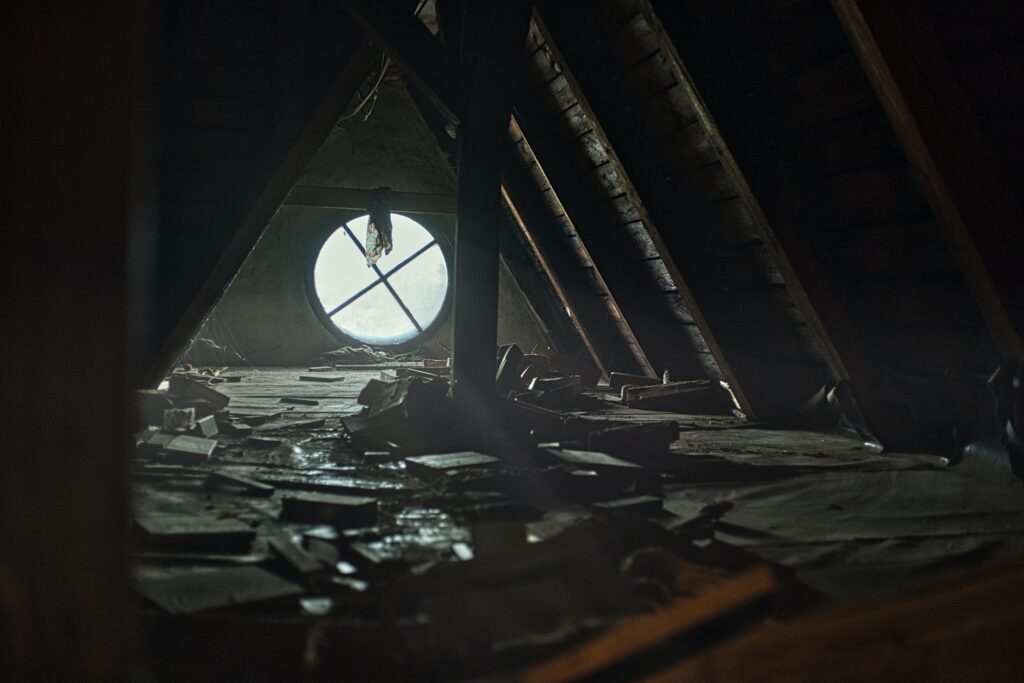Anatomy of an Attic – Everything You Need to Know
The attic is one area of the house that isn’t regularly thought about compared to the other living spaces. However, the condition of your attic can significantly improve your quality of life, so we think it deserves a lot more attention than it gets.
Anatomy of an Attic
The attic is the space between your ceiling and the roof, and as such, is the highest floor of the house. Attic sizes and shapes are as unique as house designs, but all share similar features, which we will discuss here.
Attic Framing
Your attic’s framing is its most important feature. Most older homes, and a few new ones as well, are framed with rafters that extend from a ridge board at the roof’s peak to attach to the top plate of an exterior wall. Each rafter will have some overhang, which forms the eaves of the house. Rafters are usually installed one “stick” at a time, which is why this roofing style is sometimes referred to as a “stick frame.”
The ceiling joists, which are also the attic floor joists, need to be installed before the roof rafters are attached. Framing an attic with rafters often leaves enough space to use the area for storage or extra living space like a bedroom or home office when properly renovated.
Houses constructed with roof trusses use angled web framing to connect the top chords to the bottom chords. The space beneath a trussed roof is not engineered to hold substantial loads, so should not be used for storage. However, it will be sufficiently sturdy to hold insulation.
The Building Envelope
Builders refer to the “building envelope,” which is the conditioned spaces of the building that have environmental control for improving comfort levels, such as furnaces and HVACs. By this definition, attics are outside of the building envelope.
Insulation is most often installed on the attic floor. However, when the attic is conditioned, the insulation can be installed between the rafters and sometimes directly beneath. Insulating the attic this way ensures a comfortable attic environment, whether it’s hot or cold outside.
Whenever an attic is renovated into a living space, it’s now part of the building envelope and will require insulation.
Passive and Active Ventilation Options
All unconditioned attics should have some type of ventilation; otherwise, moisture and heat can build to high levels. Too much moisture in the attic can lead to mold problems, and the excessive heat can transfer into the living spaces and make them uncomfortable. If you live in an area with cold winters, ice dams are often a sign of poor ventilation.
Soffit vents (installed along the eaves of the house) and ridge vents will ensure the attic is well-ventilated. A soffit vent works by convection. The warm air in the attic rises and escapes through the ridge vents. The same volume of cool air will be drawn through the soffit vents and into the attic.
You may have gable-end vents at either end of your attic, but these are not enough on their own. You still need soffit and ridge vents to keep the air moving. If your home does not have soffit or ridge vents, talk to an insulation professional near you to see about getting them retrofitted.
The outer surface of a roof can get extremely hot during summer, up to as high as 160° Fahrenheit (71° Celsius). The outside thermal energy radiates inward to make the attic uncomfortably warm. Unfortunately, ductwork also absorbs some of the radiant energy. Your HVAC is put under increased strain, which will reflect in your energy bill.
You can install attic fans to combat this problem. Attic fan installations are an inexpensive solution that only turns on when the attic reaches a certain temperature. You won’t be wasting energy running fans that are not needed during mild weather
Insulating your home and sealing your ductwork will also go a long way toward making your home a lot more energy efficient.
Adequate ventilation and insulation work together to create a more pleasant living environment. The insulation prevents heat from transferring to the living spaces, while the ventilation, along with attic fans, helps to keep the attic cooler and lessen the load on your HVAC system.
While the soffit, gable, and ridge ventilation system described above are essential for good airflow, other vents your home might benefit from include solar vents, power vents, and turbine vents.
Attic Insulation
Insulation in the attic is critical to creating a comfortable living environment and ensuring your home is energy efficient. The savings you get on your energy bill always make insulation a worthwhile investment. It can last two or more decades, so it will more than pay for itself over time.
A lack of attic insulation means your comfort is dependent on the outside conditions. You can also have issues with humidity and condensation.
We recommend scheduling an attic insulation inspection at least every two or three years. If your home is older, it might be worthwhile to give your insulation a checkup.
There are many different insulation types available at different price points. Ask about what will work best for your home, which could include:
- loose fill insulation (installed with blowing machines)
- fiberglass insulation
- spray foam insulation
- fiberglass batt insulation
Insulation technology has advanced over the last couple of decades, but old insulation does not perform as well and often needs replacing. You will notice a difference with new insulation, especially if your attic is currently uninsulated.
Air Sealing
Although air sealing is not technically a part of attic anatomy, it is a critical component of an energy-efficient home. Many homeowners are comfortable installing weather stripping and caulking around doors and windows as a DIY project but neglect the attic. Unfortunately, a leaking attic can undermine your efforts elsewhere in the house.
EnergyStar.gov has an excellent guide on air sealing your attic. Those who aren’t handy or aren’t physically able can still rely on professional installation services for their air sealing needs. Some of the locations around your home that could do with air sealing include:
- Attic windows and vents
- HVAC ductwork and grills
- Holes drilled for pipes and wiring
- Recessed lighting
Is Your Attic Due for an Inspection?
Your attic could benefit from a physical inspection by an attic pro. Get in touch with a member of our friendly team and book your attic for an inspection today. When you hire a pro from us, you will save money on your energy bills as well as locate and fix conditions that could mean costly repairs in the future.

